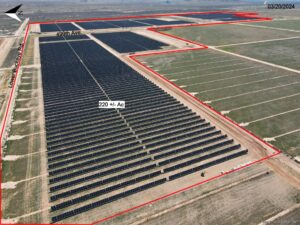solar developer taps area near Phoenix for $1.2B project

A group of investors who own approximately 30,000 acres of land in the Harquahala Valley have inked a deal to build a $1.2 billion solar project on the site and are negotiating separate deals to sell the water underneath the project, which lies about 60 miles west of Phoenix.
Salt Lake City-based Copia Power, a developer of renewable energy platforms backed by global investment firm The Carlyle Group (Nasdaq: CG), plans to invest billions in the region in an effort to develop more than 1,500 megawatts of additional renewable energy projects, said Garret Bean, managing director of strategic development for Copia Power.
Copia’s project marks the latest addition to Arizona’s growing solar industry, which ranked No. 9 in the nation in 2023 by one metric. SRP’s new Buckeye solar-battery facility is another example of a large project that recently went live.
Copia’s green energy campus is expected to span 14,000 acres, while the landowners have option agreements with other solar developers to build an additional 6,000 acres of solar on site, said Carson Brown, a partner and Harquahala Valley landowner.
“There are over 4,000 acres not under options that we expect to negotiate with solar groups on that land over the next couple of years, and I expect billions more in investment over the next five to seven years as these projects get built,” Brown said.
Bean said his team has been working on this deal for the past three years.
“Copia was familiar to the region and were introduced to the landowners through great partners,” he said. “Since that relationship formulated three years ago, we worked closely with the landowners to develop and start construction on the Harquahala projects.”
Copia secures project financing from several partners
The first two phases of Copia’s Harquahala Sun complex are expected to be completed in early 2025 and produce 450 megawatts of solar generation each year, he said. It will include a 300 megawatt/1200 MWh battery energy storage system.
San Diego-based SOLV Energy will build the projects, generating more than 700 construction jobs that will be sustained through subsequent phases of development and construction, Bean said.
In December, Copia Power secured a $1.2 billion construction-to-term loan financing package to fund the construction of its Harquahala Sun I and Harquahala Sun II solar plus storage projects.
The financing was executed by Crédit Agricole CIB, BNP Paribas, Natixis CIB, and SMBC as coordinating lead arrangers. It is one of the first structured with a non-recourse tax credit transfer bridge and term loan takeout. This leverages the flexibility provided by the Inflation Reduction Act’s tax credit transfer provisions, rather than a traditional tax equity and term loan takeout.
The solar rays in Harquahala Valley are some of the most intense in the southwest, and its proximity to Delaney Substation make it an ideal location for solar projects, Brown said.
“This region is ideal for renewable energy with existing and planned transmission infrastructure, great sun and supportive landowners and community members,” Bean said. “We anticipate future phases of the project coming online in the following years and through 2028.”
At full capacity, he expects the project to be 2,000 MW, which is enough energy to power more than 500,000 homes.
“This project will be essential in meeting the increasing power demands of Arizona residents and businesses,” Bean said.
Buckeye, Queen Creek could benefit from water rights
Meanwhile, the owners of this property are also in talks to sell Harquahala’s underground water supply to Queen Creek and Buckeye, two municipalities that are not designated water providers. Water security is an increasingly high priority as Valley municipalities continue to grow at a breakneck space.
Paul Gardner, assistant town manager for Queen Creek, said his team is nearly finished with an application to the Arizona Department of Water Resources to transport 5,000 acre feet per year over the next 100 years.
The city of Buckeye has a concurrent application for nearly 6,000 acre feet of water to be transported over the next 100 years, he said.
Gardner said he hopes the water department will have reached a decision by the end of May. While price negotiations are still ongoing, he expects to pay around $7,000 an acre foot, or $35 million for the 5,000 acre feet.
“We have large industrial projects coming to Queen Creek,” Gardner said. “This water may be used for that.”
There are major power grids between Arizona and California that go right by the Harquahala property, Gardner said.
“It doesn’t get much hotter than Harquahala,” he said. “Now you have renewable projects going on. It’s a double win for the state.”
Petra Schadeberg-Hermann, co-managing partner of Krombacher Brewery, one of the largest private breweries in Germany, is an investor in Harquahala who recently sold hundreds of acres to homebuilders at her Soleo master-planned community in Queen Creek.
“With all the chip plants being built in Phoenix all needing so much energy, to have solar on top of it and the water is really a perfect match,” she said. “Harquahala is a perfect location for solar. It’s flat land, there is nothing to shade it. There are no trees. It’s really a perfect location for solar.”
Before signing this solar deal with Copia Power, the landowners had been leasing the land to farmers, who grew alfalfa and shipped product out of state and oversees, Brown said.
Some already have stopped farming operations, and the balance will voluntarily stop farming in the near future, he said, allowing for water to be conserved for a better use, according to Brown. He noted that there are a lot of chip manufacturers, data centers and other businesses looking to locate in Arizona that need water and will potentially benefit from this water in Harquahala Valley.
“The land is driving billions in investment, hundreds of jobs and new infrastructure that will provide water and energy to grow Arizona communities and businesses,” Copia Power’s Bean said.
